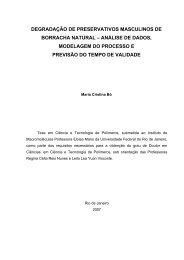EXAFS as a tool for catalyst characterization: a review of the ... - INT
EXAFS as a tool for catalyst characterization: a review of the ... - INT
EXAFS as a tool for catalyst characterization: a review of the ... - INT
You also want an ePaper? Increase the reach of your titles
YUMPU automatically turns print PDFs into web optimized ePapers that Google loves.
There<strong>for</strong>e, <strong>the</strong> <strong>EXAFS</strong> analysis demonstrated that <strong>the</strong> alloy ph<strong>as</strong>e w<strong>as</strong><br />
<strong>for</strong>med during reduction, <strong>as</strong> already shown by magnetic and X-ray<br />
diffraction me<strong>as</strong>urements (Noronha, 1994). The bimetallic particles<br />
consist <strong>of</strong> both palladium and cobalt rich ph<strong>as</strong>es.<br />
CONCLUSIONS<br />
A <strong>review</strong> <strong>of</strong> <strong>the</strong> <strong>EXAFS</strong> data analysis methods w<strong>as</strong> presented. A<br />
detailed description <strong>of</strong> <strong>the</strong> <strong>EXAFS</strong> signal extraction and <strong>the</strong> Fourier<br />
trans<strong>for</strong>m <strong>of</strong> <strong>the</strong> data were discussed. The procedure <strong>for</strong> determining<br />
interatomic distances, coordination numbers and disorder effects<br />
from <strong>EXAFS</strong> data w<strong>as</strong> described. These parameters were calculated in<br />
order to obtain both fur<strong>the</strong>r evidence <strong>of</strong> Pd-Co interaction and <strong>the</strong><br />
mean composition <strong>of</strong> bimetallic particles.<br />
NOMENCLATURE<br />
Aj(κ ) <strong>the</strong> backscattering amplitude from each <strong>of</strong> <strong>the</strong> N j neighboring<br />
atoms<br />
E photoelectron energy<br />
E 0 energy <strong>of</strong> <strong>the</strong> absorption edge<br />
Planck`s constant divided by 2π<br />
h.ν energy <strong>of</strong> <strong>the</strong> X-ray photon<br />
I 0 photon intensities be<strong>for</strong>e <strong>the</strong> absorber<br />
I photon intensities after <strong>the</strong> absorber<br />
m m<strong>as</strong>s <strong>of</strong> <strong>the</strong> electron<br />
N j number <strong>of</strong> atoms in <strong>the</strong> j th shell<br />
N ind number <strong>of</strong> independent points<br />
N par number <strong>of</strong> parameters<br />
p i fitting parameters







![ABM 2012 Torquímetros 20801[1].pdf - INT](https://img.yumpu.com/35773768/1/184x260/abm-2012-torquimetros-208011pdf-int.jpg?quality=85)




![Resumo biodiesel 2012 Raquel Rev cla[1].pdf - INT](https://img.yumpu.com/27723744/1/184x260/resumo-biodiesel-2012-raquel-rev-cla1pdf-int.jpg?quality=85)



